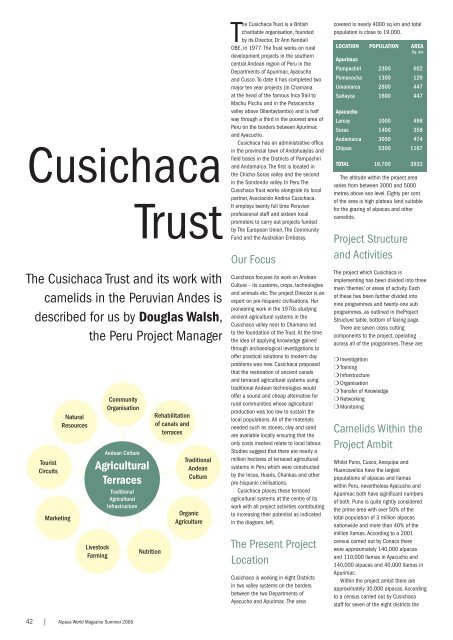Alpaca World Magazine Summer 2005 - Classical MileEnd Alpacas
Alpaca World Magazine Summer 2005 - Classical MileEnd Alpacas
Alpaca World Magazine Summer 2005 - Classical MileEnd Alpacas
- No tags were found...
Create successful ePaper yourself
Turn your PDF publications into a flip-book with our unique Google optimized e-Paper software.
CusichacaTrustThe Cusichaca Trust and its work withcamelids in the Peruvian Andes isdescribed for us by Douglas Walsh,the Peru Project ManagerThe Cusichaca Trust is a Britishcharitable organisation, foundedby its Director, Dr Ann KendallOBE, in 1977. The Trust works on ruraldevelopment projects in the southerncentral Andean region of Peru in theDepartments of Apurimac, Ayacuchoand Cusco. To date it has completed twomajor ten year projects (In Chamanaat the head of the famous Inca Trail toMachu Picchu and in the Patacanchavalley above Ollantaytambo) and is halfway through a third in the poorest area ofPeru on the borders between Apurimacand Ayacucho.Cusichaca has an administrative offi cein the provincial town of Andahuaylas andfi eld bases in the Districts of Pampachiriand Andamarca. The fi rst is located inthe Chicha-Soras valley and the secondin the Sondondo valley. In Peru TheCusichaca Trust works alongside its localpartner, Asociación Andina Cusichaca.It employs twenty full time Peruvianprofessional staff and sixteen localpromoters to carry out projects fundedby The European Union, The CommunityFund and the Australian Embassy.Our FocusCusichaca focuses its work on AndeanCulture – its customs, crops, technologiesand animals etc. The project Director is anexpert on pre-hispanic civilisations. Herpioneering work in the 1970s studyingancient agricultural systems in theCusichaca valley near to Chamana ledto the foundation of the Trust. At the timethe idea of applying knowledge gainedthrough archaeological investigations tooffer practical solutions to modern dayproblems was new. Cusichaca proposedthat the restoration of ancient canalsand terraced agricultural systems usingtraditional Andean technologies wouldoffer a sound and cheap alternative forrural communities whose agriculturalproduction was too low to sustain thelocal populations. All of the materialsneeded such as stones, clay and sandare available locally ensuring that theonly costs involved relate to local labour.Studies suggest that there are nearly amillion hectares of terraced agriculturalsystems in Peru which were constructedby the Incas, Huaris, Chankas and otherpre-hispanic civilisations.Cusichaca places these terracedagricultural systems at the centre of itswork with all project activities contributingto increasing their potential as indicatedin the diagram, left.The Present ProjectLocationCusichaca is working in eight Districtsin two valley systems on the bordersbetween the two Departments ofAyacucho and Apurimac. The areacovered is nearly 4000 sq km and totalpopulation is close to 19,000.LOCATION POPULATION AREASq. kmApurimacPampachiri 2300 602Pomacocha 1300 129Umamarca 2800 447Sañayca 1600 447AyacuchoLarcay 1000 498Soras 1400 358Andamarca 3000 474Chipao 5300 1167TOTAL 18,700 3933The altitude within the project areavaries from between 3000 and 5000metres above sea level. Eighty per centof the area is high plateau land suitablefor the grazing of alpacas and othercamelids.Project Structureand ActivitiesThe project which Cusichaca isimplementing has been divided into threemain ‘themes’ or areas of activity. Eachof these has been further divided intonine programmes and twenty-one subprogrammes, as outlined in theProjectStructure table, bottom of facing page.There are seven cross cuttingcomponents to the project, operatingacross all of the programmes. These are:❍ Investigation❍ Training❍ Infrastructure❍ Organisation❍ Transfer of Knowledge❍ Networking❍ MonitoringCamelids Within theProject AmbitWhilst Puno, Cusco, Arequipa andHuancavelica have the largestpopulations of alpacas and llamaswithin Peru, nevertheless Ayacucho andApurimac both have signifi cant numbersof both. Puno is quite rightly consideredthe prime area with over 50% of thetotal population of 3 million alpacasnationwide and more than 40% of themillion llamas. According to a 2001census carried out by Conacs therewere approximately 140,000 alpacasand 110,000 llamas in Ayacucho and140,000 alpacas and 40,000 llamas inApurimac.Within the project ambit there areapproximately 30,000 alpacas. Accordingto a census carried out by Cusichacastaff for seven of the eight districts the42 | <strong>Alpaca</strong> <strong>World</strong> <strong>Magazine</strong> <strong>Summer</strong> <strong>2005</strong>







